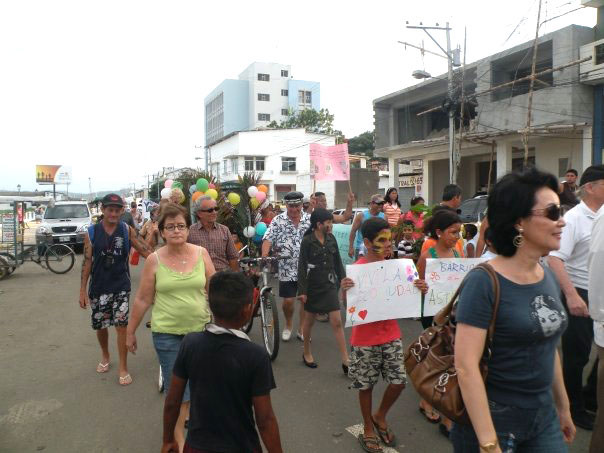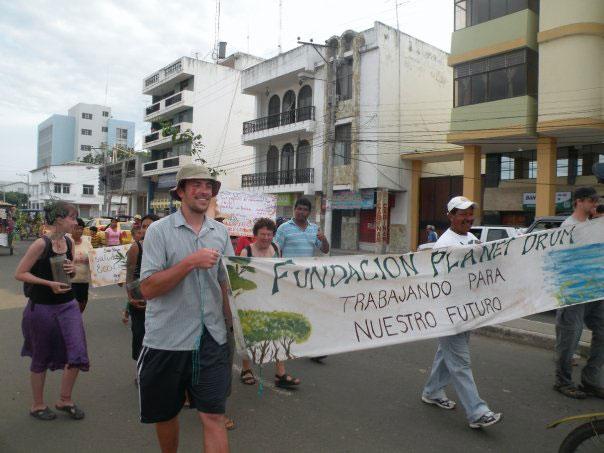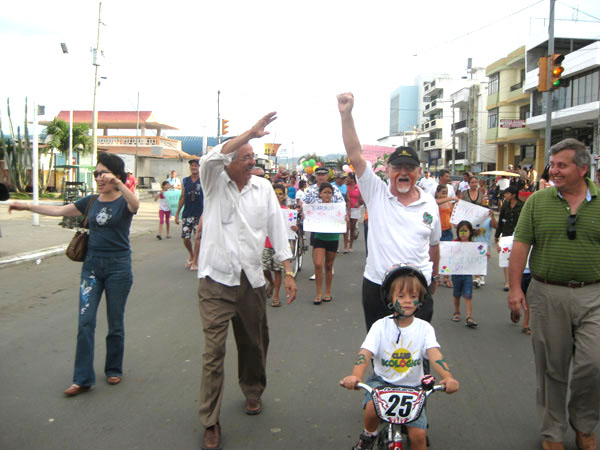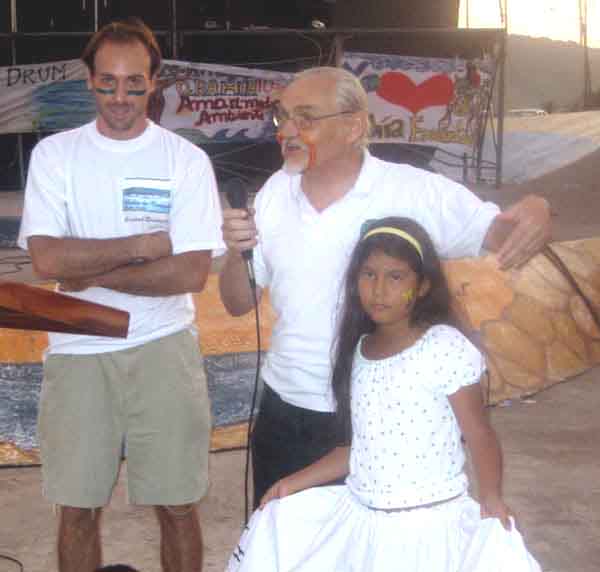Bahia de Caraquez, Ecuador
The high-pitched enthusiasm of Carnaval is building and an interviewer/photographer team from Taiwan’s Spirit magazine has arrived to report on Eco-Bahia, requesting a tour by me through Bosque en Medio de las Ruinas “wild park.” We were graced with a rainless day to climb down the steps at the farthest entrance accompanied by Patricio Tamariz (who had arranged for the Taiwanese visit), Clay and several Planet Drum volunteers with natural sciences backgrounds. The group was awed by the several hundred years old giant Ceibo tree that is a sentinel at the park entrance, the totem species of the Dry Tropical Forest with unique human-like jointed arms, green skin and potbellied trunk.
Clay and the whole crew had cleared paths within the site for three feet on each side a few days before so the going was smoother than usual. Thorny vines can become strung across paths like multiple strands of vegetative barbed wire in this rapid plant-growth time of year. The seclusion and wildness of the Bosque so close to the houses and streets of the city always impresses first-time visitors. We were only two blocks from the main public market and four blocks from City Hall. Blaring radio salsa music from relatively close-by competed with the liquid calls of Linchero birds as the background sound for viewing the Bosque’s thickly growing native forest. Trees only seven years old or less are now between 45 and 65 feet tall and no longer look like widely spaced fresh additions. Stubby bamboo watering tubes with red, green or blue markings to identify the various years when the trees were planted have split apart and rotted to begin making soil as we had hoped. Red-orange center-dotted butterflies and camouflaged light brown ones with white edges to resemble tree bark were everywhere. The photographer spotted some barefoot silent children from the closest bamboo houses who suddenly appeared from within the native forest and took portrait shots of them.
The Spirit team later interviewed 15 year-olds Raisa and Roberto from the Bioregional Education classes along with their teacher Ramon Cedeño. Asked whether general residents of the city shared their energetic enthusiasm about environmental concerns, Roberto answered that the process was similar to everyone adding single grains of sand until they created a hill. “If everyone does just one thing, they will all add up to make an ecological city.” Raisa spoke about her parents learning things from her such as separating garbage, making compost and growing fruit trees. Both students intend to pursue environmental careers.

Carnaval broke as a full force storm the next Monday with bathing suit clad crowds jamming sidewalks for many blocks of the Malecon, lined everywhere now with vendors’ carts and tents. It was also the Eco-City Celebration Day beginning at 9:30 in the morning with what was hoped to be a well-attended open house for environmentally concerned organizations in the breezeway under City Hall. Planet Drum Foundation had a half-dozen colored banners, at least two-dozen nursery saplings in containers, descriptive posters, three staffers including Ramon with a monkey he rescued when its mother was shot by a hunter, and at least fifteen volunteers and friends. But except for a single display table from Cerro Seco Reserve, no one else showed up. And the total number of visitors for the entire duration until noon was probably less than that of presenters. Our spirits were still high but the outlook for the parade slated for 5 o’clock was starting to dim.
Planet Drum volunteers were assisting three barrios that were competing for prizes as best-decorated participants in the parade. This was a first-time experiment to help produce good results with the addition of volunteers because there was only a short two-week notice about the competition. Marketa, a superlatively industrious Czech woman volunteer, was the first chosen to increase the likelihood of success. She and all of the subsequent volunteers who become neighborhood helpers reported a continuing tension between themselves and the residents about who was supposed to come up with ideas and who would actually work on making decorations. The volunteers saw themselves as auxiliary assistants but the neighborhood people seemed to want them to decide what should be done and do it mainly by themselves. The problem with this flawed collaboration was that when decisions were made and half-accomplished the neighbors began altering them in different directions (as they should have at the beginning). The parade outlook was becoming darker. There were some spots of light, however. Enough money had been collected from merchants and individuals to make substantial prizes, Mark Hebard’s excellently hand-written announcement posters had been placed at strategic spots around town, and media spots were being heard on the radio and read in newspapers. Some volunteers were still out helping neighborhood groups up to the last minute. But no one was comfortable in predicting that the procession would be a success.
At four o’clock with only an hour before the march was supposed to start another obstacle was encountered. Clay learned that the city police wouldn’t permit the parade to circuit the Malecon as originally planned because it would become clogged with too many Carnaval bathers leaving beaches at the march’s scheduled time. We were directed to go down Simon Bolivar Avenue in the City Center which was almost totally abandoned. “Call the mayor,” I suggested, “or ask Patricio to call him to wave off the police.” (Patricio had just been appointed Assessor of the Environment to advise the mayor.) Clay had calls out to both of them already but wasn’t getting an answer. As the parade starting time approached we decided to bull-headedly go with our volunteers to the original starting point on the Malecon anyway.
There were barrio residents and children waiting with us at the assembly area when Patricio arrived with the official Governmental Representative from Taiwan who had joined the magazine team. The mayor was finally contacted and it was decided to go to a new jump-off point in front of the main cathedral where we found even more barrio residents and children waiting. Children and adults from one neighborhood were being face-painted to represent butterflies and pumas, while another had a girl costumed as a policeman accompanying a chain saw on a triciclo representing attacks on Nature. Surprisingly, the mayor himself arrived along with three police motorcycles to clear the way.
We were still absorbed in preparations when a rough starting line headed by the motorcycles slowly began moving….toward the Malecon! At this point enough participants with painted faces and posters bearing slogans had joined to make a substantial parade.

The throng stopped when reaching the chosen riverfront route to form up and to make sure we were all together.As we finally began to walk forward I felt an overwhelming disinhibited surge of relief and loudly shouted “Viva la Eco-ciudad!”“Viva, viva, viva!” the paraders shouted back.

More people began exclaiming their own vivas for “Green City”, “Eco-Bahia”, “Recycling”, “Zero Garbage”, “Reused Water”, “Eco-business”, “Birds”, “The Sea”, “Compost” and so on. One San Roque resident whose bare chest was painted with an assortment of invented symbols (he had joked earlier about resembling an inhabitant from 2,000 years ago) began a constant outcry of joyful cheers that gradually made him almost inaudible from hoarseness.

Thousands of visiting bathers along the parade route stood smiling or in open-mouthed astonishment. Some local residents shouted encouragement, pumped their arms or holding up fingers in V’s. Citizens ran up from the sidewalk to shake the mayor’s hand. Dancing broke out whenever we encountered loud radio music. I linked arms with the mayor and he uttered his own “Viva la Eco-ciudad!” with quiet discretion.

There was a wonderful absence of a uniformed band or anything commercial or mass-produced among the marchers. It was a haphazard and uncoordinated conglomeration that accurately represented the diversity of its participants. Costumes were all homemade and amazingly inventive like the young girl who wore a conical hat made of thatch, with thick leaves covering her body and ankle-bands of twisted leaves. Numerous beautifully handmade posters proclaimed slogans such as that carried by a ten-year old girl that said “The Children Don’t Want Pollution!”

The cart that carried a life-size representation of beloved Miguelito the Galapagos Tortoise was designed as a kind of theater thickly decorated with leaves. Marketa marched holding a potted plant on her head.
The march ended at a circular park on the Malecon that was set-up to host a concert later that night. I was unexpectedly asked to sit at the table with a panel of speakers including Patricio, the Taiwan diplomat, and the mayor.

Marcelo Luque, director of Cerro Seco Reserve, made opening remarks and introduced Patricio to give a fairly detailed history of the Eco-Ciudad. I didn’t have a speech in mind and could barely unhitch mentally from the arms-linked, shouting mood of the march. A girl wearing a dress with an artfully painted representation of the city beach with its red and white lighthouse sat in the first row. How old was she, I wondered, and walked toward her hunched over to minimize the distraction. “Nine,” she replied but her mother corrected, “She’ll be ten in a few weeks.” I was saved because this would be the key to my improvised speech.

Patricio motioned for me to be next speaker so I went to the podium and faced perhaps a thousand smiling faces. “The eco-ciudad is ten years old, Viva la Eco-ciudad!” Came out of my mouth as though the parade was still in progress. Clay quickly joined me to translate the English parts into Spanish. “What does ten years old look like?” I questioned the crowd and gestured to the girl to join me. We had spoken about my calling her and she complied quickly. “This is what it looks like.” The crowd applauded and she stood holding out her dress at the sides so that the full painted scene could be viewed.

I stated that we had only begun transforming Bahia into an ecological city and it was not yet an adult, listing some of the main changes in activities and infrastructure that needed to be made before we could claim full maturity. Ecuador’s new constitution with its Rights of Nature was the first of its kind in the world (“Viva Ecuador!”) and the city needed to take a similar leap forward.

“In another ten years this girl will be a beautiful woman and the eco-city will also be twenty years old. When that time comes we can show the world what the best model of a true ecological city looks like.” The crowd exploded with applause and cheers. I added that we couldn’t give up hope, that we needed more money but it would come, more time and energy were also needed but they would come. After a final “Viva la Eco-ciudad!” I floated away from the podium in a dazed state as first Patricio and then the mayor pumped my hand with heads nodding in approval and broad smiles on their faces.
Ingrid Hsing, the veteran woman diplomat from Taiwan, followed with a polite and professional speech in excellent Spanish. Mayor Carlos Mendoza delivered a somewhat long, surprising environmentally concerned speech that was probably prompted by this being an election year and his awareness that he was previously disfavored by the crowd. The Eco-city hadn’t been a priority during his four-year administration and that was the reason it needed to be rescued. Next, Marcelo of Cerro Seco Reserve introduced his British volunteer Kathy, an expert in alternative energy, to describe their current bio-digester project to make cooking gas from organic wastes, and ended with some remarks about it of his own.
The speaking session had begun with Ecuador’s national anthem. Now it closed with playing a recording of the upbeat Eco-Bahia song composed for the original celebration ten years ago. We all stood and were initially as solemn as during the playing of the national anthem, but by the beginning of the second chorus some swaying began that blossomed into full-scale, joyous dancing in all imaginable styles until the end. The crowd was ecstatically happy. The rescue of the eco-ciudad that Patricio and Clay envisioned when the 10th Anniversary Celebration was planned had begun.

Your article helped me a lot, is there any more related content? Thanks!